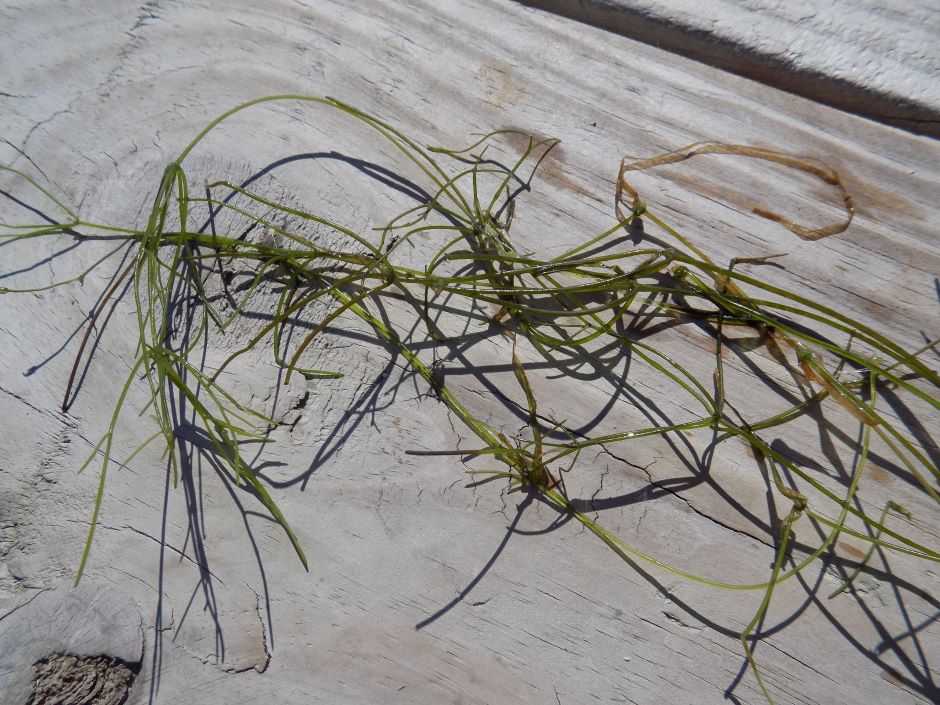Invasive Starry Stonewort Shaping Ecosystems
 (Credit: mbelitz, CC0, via Wikimedia Commons)
(Credit: mbelitz, CC0, via Wikimedia Commons)When thinking of invasive species, most would think immediately of invasive animals, but vegetative invaders are just as common and harmful to ecosystems. Previously productive and healthy lakes have been infected by starry stonewort, an invasive aquatic plant that has become a hazard across the northwestern U.S., with reports running from Michigan to Vermont. Though plant diversity is often considered to be less critical than animal populations, vegetation is an important part of fish diet and habitat while contributing (or inhibiting) productivity in a water ecosystem.
“Starry stonewort is native to Eurasia, from the west coast Europe to Japan,” according to the Minnesota DNR. It is believed that the species was unintentionally introduced to the Great Lakes through the discharge of a contaminated cargo ship. While starry stonewort was first documented in 1978 along the St. Lawrence River, the species quickly spread up the northwestern border of the U.S.
The Wisconsin DNR describes starry stonewort as “a submerged annual microalga known to cause nuisance conditions in Michigan, New York and Indiana.” The species invades lakes, rivers, reservoirs and ponds, wherein it quickly reproduces. The starry stonewort then outcompetes native aquatic vegetation and reduces fish spawning habitats due to their monotypic stands.
Starry stonewort impacts both plants and animals in ecosystems. The MDNR cites the following as some of the starry stonewort’s impacts:
- “Dense mats at the water’s surface inhibit water recreationists.
- Overtakes habitat and outcompetes native aquatic plants, potentially lowering diversity.
- Provides unsuitable shelter, food, and nesting habitat for native animals.”
Identifying Starry Stonewort
Once reaching maturity, starry stonewort can be identified by its “Whorls of 4-6 branchlets (leaves) with blunt tips, irregular length branchlets are arranged along the main thallus (stem),” descript the WDNR. The most recognizable stage for the species is before the plant has matured. Reproduction occurs via fragments of vegetative structures called bulbils which appear to suit the species’ name. The bulbils are 3-6 mm wide with five distinct points branching off the center of the white structure. The star-shaped bulbils are produced at the plant’s nodes and are typically found on the plant’s rhizoids.
The whorls radiate and spiral out from a single point around the stem and away from the stem nodes. Stem nodes can be identified as the point wherein a cluster of whorls extends out from. Between nodes, there is an intermodal segment that will not produce whorls. Since starry stonewort is a macroalga, it does not have a vascular system, and each branchlet is a single cell.
While the species can naturally occur as either male or female, all known introduced populations in North America are male and reproduce asexually. While the bulbils can be seen throughout the growing season, the MDNR reports that they are most obvious and plentiful in the late summer.
It’s important to note that the species has a few lookalikes, two of which are Nitella and Chara, and all of which share similarities in their mature forms. The best way of differentiating the species is by sampling the vegetation present in the area. Starry stonewort may have some of the star-shaped bulbils attached to the plant’s rhizome, helping to identify the invasive plant.

Starry Stonewort (Credit: Minnesota Department of Natural Resources, Public Domain via Flickr)
Starry Stonewort Impacts and Control Strategies
In order to stop the spread of starry stonewort, several states have implemented restrictions and guidelines for water recreationists. While policies vary from state to state, some common and beneficial practices are to clean watercrafts, drain all water from water equipment, dispose of unwanted bait, and dry equipment for 21 days before entering another water body.
The bulbils are small and may become hidden in mud and debris or stick to trailer bunks, anchors, ropes, fabric and footwear. The bulbils may also attach themselves to scuba, fishing and hunting gear allowing the species to spread to new areas. Even one bulbil entering an uncontaminated water body can result in a new population since the species can reproduce asexually.
Most states encourage reporting any sightings of starry stonewort to local environmental authorities, who will begin treatment. Treatment strategies should only be conducted by qualified individuals to avoid harming the natural ecosystem. Most often, a mechanical or herbicide control strategy is deployed against the macro-algae.
The MDNR defines mechanical strategies as hand-pulling, suction dredging, diver assisted suction harvesting and utilizing other aquatic vegetation harvesting equipment. Herbicide control strategies involve the use of contact herbicides, like endothall, copper, and diquat.
By treating current infestations and preventing further spread, starry stonewort could be eradicated. However, control and treatment strategies must continue with the conjoined effort from water recreationists who can help keep water healthy and starry stonewort-free.



Pingback: FishSens Magazine | Asexual Reproduction in Female Cichlids - FishSens Magazine
Pingback: FishSens Magazine | Proposed Net-Pen Aquaculture Facilities in Michigan - FishSens Magazine